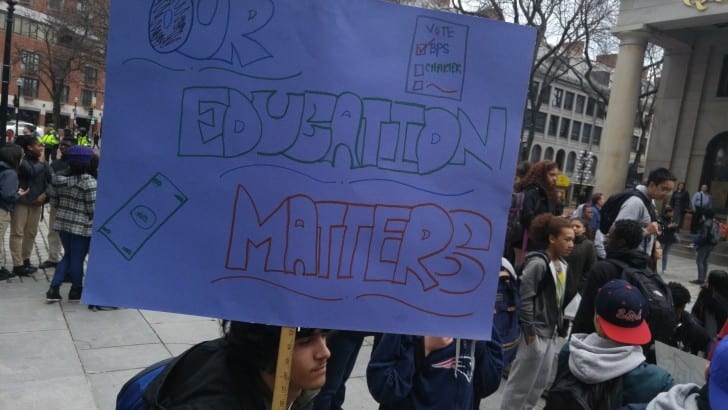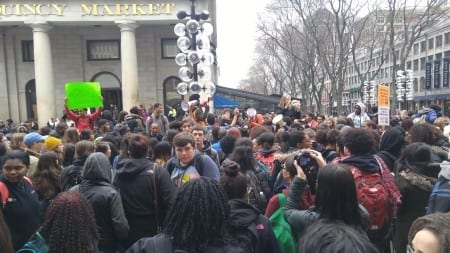
Photos by Chris Faraone
March 10, 2016
BY JASON PRAMAS @JASONPRAMAS
With their schools facing up to a $50 million deficit next year, over 2,000 Boston Public School students from all over the city marched on the Massachusetts State House and Boston City Hall this week to demand that BPS be properly funded going forward.
Clearly the messaging and targeting of the action owed a lot to BPS parents groups and teachers unions who have become more militant of late as the funding situation has grown worse. Thanks to budget-stealing charter schools being pushed by Mayor Marty Walsh and Governor Charlie Baker—and the pair’s shameful recently inked deal to throw upwards of $270 million in public funds and tax breaks at General Electric to move their headquarters to Boston. Resulting in lots of “Million$ for GE, Budget Cuts for Schools” stickers and at least one “Fuck GE” sign being sported by the young activists. Plus at least one other student yelling “One Term Walsh” from a megaphone opposite Boston City Hall during the demo, according to Universal Hub. But no one forced these kids to take to the streets. They know when they’re being screwed. And who’s doing it.
All of which foreshadows the political payback to come. In part from the many BPS student protestors who will be able to vote in the next mayoral election. Leaving Walsh on the defensive at a speech to the Boston Municipal Research Bureau—a business-oriented think tank— the day after the student protest. Trying to explain how the massive giveaway to one of the worst corporate criminals on the planet is a fine idea that will somehow make Boston the first polity that it doesn’t completely screw over.
Which probably explains the Boston Globe subsequently reporting that the mayor was “fuming” about the protest in a piece that went fishing for evidence that the teachers unions were manipulating the students for their own ends. Walsh is running scared. Unfortunately for him, although coming off as rather eager to point the finger at union-led pro-public education coalitions like the Boston Education Justice Alliance (BEJA) and the national Alliance to Reclaim Our Schools, the Globe discovered that the students really did organize the big protest themselves—with coalitions like BEJA playing only supporting roles. The Boston Herald, meanwhile, contented itself with straight union bashing.

What’s unspoken is that the best proof that the unions didn’t have much of a role in the protest is that historically they’ve shown little ability to mobilize significant numbers of students in the Bay State. Typically, union-backed coalitions like BEJA will pull a few dozen to a few hundred people to such protests. Students or non-students, the story is always the same. The people who turn out will be a mix of union and nonprofit staffers—paid advocates, although often not specifically paid to work on a particular campaign and doing so in their spare time—and dedicated activists from the involved communities. That is, the generally small number of people who are motivated enough to take a stand on any given issue. Even one so important as the future of public education.
For really important actions, unions (and allied nonprofits) will do their best to bus in members from around the region. But even then, numbers will often be disappointing because—right-wing conspiracy theories to the contrary—unions don’t control their members. They can pay for transportation to make it easier for members to turn out to political actions from a broad enough geographic area to bulk up their usual numbers, but they have no way of forcing members to participate. Especially when important local and state hearings are often held at inconvenient times for working people and students alike.
If their control over their members is minimal, union control over K-12 students is nonexistent. This is one reason why last month’s BEJA-led protest drew only a couple hundred activists. A portion of whom were students who had been activated by BEJA member-organizations like the Boston-area Youth Organizing Project (BYOP). Yet it is precisely the ability of groups like BYOP to educate young people on important issues like public education funding over years that was really behind Monday’s action. Students, as human actors, are perfectly capable of looking at the available information on a topic like education reform and making their own decisions. But even the best grassroots political organizers can’t predict when or even if their educational work will ever pay off with mass mobilization on their core issues. Plus with every issue having at least two sides, it’s always possible that students will back the charters—and some definitely do.
In this case, and to their credit, lots of Boston students have decided to back the underdogs in the charter school debate—teachers unions, parents groups, and other advocates for a strong public education system. Rather than the extremely well-funded pro-charter groups. Many students heard about the looming cuts to the BPS budget, on the heels of years of similar cuts, from both the news media, their unionized teachers, advocacy coalitions like BEJA, and youth organizations like BYOP. Then they got angry. Then they got active.
So the big props for this student action go to the young people who turned out their classmates for what was—for many of them—their first protest. From Snowden International School students who sent out an initial call on social media last week to other incipient student leaders from Boston Arts Academy, both Boston Latin campuses, Jeremiah Burke High School, Brighton High School and many more, Boston’s best and brightest young people organized a cross-class, multiracial walkout. On a school day. At significant risk of getting disciplined by their pro-charter administration. To demand redress. To demand that their city and state governments fund their right to a decent K-12 education.
Some of the student protestors, including key youth organizers, were connected to the existing pro-public education coalitions that were inside the State House on Monday morning testifying to the Joint Committee on Education to #KeepTheCap on the number of charter schools allowed in Massachusetts. But it was the existential crisis facing BPS students that impelled so many of them to take action on their own behalf. On their own terms. Making it, without a doubt, one of the best grassroots political demonstrations Boston has seen in quite some time. Much like the Market Basket workers movementtwo years ago. And that’s why the students made such a powerful impression, and immediately won over large swaths of the general public over to their cause. Locally and nationally.
Mayor Walsh may be angry that the students were bold enough to call him out on the charter issue—and related issues like the GE Boston Deal. But he has only himself to blame. He can’t have it both ways: sucking up to the rich and powerful, and being a man of the people. He has to choose. Is he for the students of Boston? Or against them? Right now, it’s looking like the latter.
Apparent Horizon is syndicated by the Boston Institute for Nonprofit Journalism. Jason Pramas is BINJ’s network director.
Copyright 2016 Jason Pramas. Licensed for use by the Boston Institute for Nonprofit Journalism and media outlets in its network.